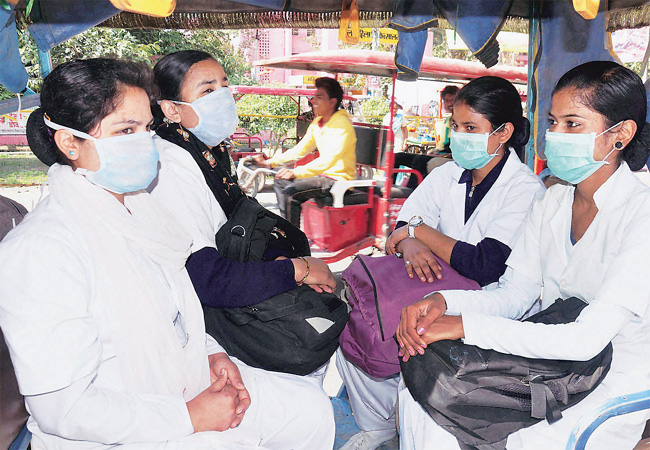
The Indian Armed Forces are under the management of the Ministry of Defence of the Government of India. With strength of over 1.4 million active personnel, it is the world’s second-largest military force and has the world’s largest volunteer army.
Post-independence in 1947, India restructured its defense system. The partition of India led to the creation of Pakistan, and both nations inherited a divided armed force. India established the Indian Armed Forces, consisting of the Indian Army, Indian Navy, and Indian Air Force. This period marked the inception of a comprehensive and autonomous defense structure.
Defence Setup and Structure:
Indian Army: The Indian Army, with its extensive infantry, artillery, and armored regiments, is one of the largest in the world. It is primarily responsible for land-based military operations and safeguarding India’s borders.
Indian Navy: The Indian Navy secures the maritime interests of the nation, safeguarding coastal borders and ensuring maritime security. It operates surface ships, submarines, and aircraft carriers.
Indian Air Force: The Indian Air Force is responsible for aerial defense, protecting Indian airspace and supporting ground operations. It operates fighter planes, transport aircraft, and helicopters.
Defence Reforms in India
Over the years, India has undertaken various defense reforms to modernize its armed forces, incorporating sophisticated weaponry, technology, and training programs. The establishment of defense research institutions, such as the Defence Research and Development Organisation (DRDO), is aimed at indigenous development and innovation in defense technology.
Contemporary Defence Challenges
India faces multiple defense challenges, including territorial disputes, cross-border conflicts, terrorism, and internal security threats. The complex geopolitical landscape in the region, especially the border issues with Pakistan and China, demands a robust and responsive defense mechanism.
International Defence Collaborations of India
India has entered into strategic partnerships and defence agreements with various countries to enhance its defense capabilities. The country engages in joint military exercises, technology collaborations, and military exchanges with several nations globally.
The history of India’s defense system reflects a continuous evolution from ancient times to a modern, independent nation. The defense apparatus has significantly evolved to adapt to various geopolitical changes, technological advancements, and national security challenges. India continues to fortify its defense system by adopting progressive reforms, modernizing its armed forces, and fostering international collaborations to ensure its territorial integrity and national security.
The journey of India’s defense system is an amalgamation of historical legacies, colonial influences, and contemporary advancements, shaping a robust structure committed to securing the nation’s sovereignty and integrity.
The Indian Armed Forces have been engaged in a number of major military operations, including: the Indo-Pakistani wars of 1947, 1965 and 1971, the Portuguese-Indian War, the Sino-Indian War, the 1967 Cho La incident, the 1987 Sino-Indian skirmish, the Kargil War, and the Siachen conflict among others. India honors its armed forces and military personnel annually on Armed Forces Flag Day, 7 December. Armed with the nuclear triad, the Indian armed forces are steadily undergoing modernization, with investments in areas such as futuristic soldier systems and missile defense systems.
The Department of Defense Production of the Ministry of Defense is responsible for the indigenous production of equipment used by the Indian Armed Forces. It comprises 16 Defense PSUs. India remains one of the largest importer of defense equipment with Russia, Israel, France and the United States being the top foreign suppliers of military equipment. The Government of India, as part of the Make in India initiative, seeks to indigenise manufacturing and reduce dependence on imports for defense.
Boosting defence exports and enhancing Atmanirbharta
Previously, India was known as an arms importer. However, the country has now risen from its comfort zone, securing a place among the top 25 arms-exporting nations. Just 7-8 years ago, defence exports barely touched Rs 1,000 crore. Today, they have surged to Rs 16,000 crore.
Projections suggest that by 2028-29, annual defence production will reach Rs 300,000 crore, with defence exports hitting Rs 50,000 crore.
While the government supports major corporations, it also encourages young minds to join the defence sector through startups, considering it a crucial step for the long term. Recent measures, including liberalising procurement from startups, payment terms, and eligibility criteria, were adopted during a Defence Acquisition Council meeting.
The Department of Defence Production issues authorisations for exporting Munitions List items covered in Category-6 of Special Chemicals, Organisms, Materials, Equipment, and Technologies (SCOMET), following Standard Operating Procedures (SOP) issued by the DDP.
Major defence equipment exported in the last five years includes weapon simulators, tear gas launchers, torpedo loading mechanisms, alarm monitoring and control systems, night vision monoculars and binoculars, lightweight torpedoes, fire control systems, armoured protection vehicles, weapons locating radar, high-frequency radios, and coastal surveillance radar systems, among others.
India’s Nuclear Doctrine
India has possessed Nuclear Weapons. The first nuclear test was carried out in 1974, under the operation named “Smiling Buddha”. Once again India tested Nuclear weapons in the year 1998, under the name “Operation Shakti”. It would not be right to call India a Nuclear superpower as 90% of the worlds’ nuclear weapons are in the possession of Russia and USA.
What type of Nuclear bomb
does India have?
India has neutron, fission and thermonuclear weapons which yields up to 200 Kilotons. Pokhran-II had 5 detonations, one was a fusion bomb and the remaining 4 were fission bombs. The bombs can be launched via land, air and sea, thus making India to be one of the few nations of the world who are nuclear triads.
How many land-based Nuclear Missiles does India have?
Strategic Forces Command controls and deploys 68 nuclear warheads (estimated) of land-based nuclear weapons of the country. It uses both vehicles and launching silos varieties.
How will the air-based missiles be launched?
In addition to their ground-attack role, it is believed that the Dassault Mirage 2000s and SEPECAT Jaguars are able to provide a secondary nuclear-strike role. The SEPECAT Jaguar was designed to be able to carry and deploy nuclear weapons.





Be the first to comment